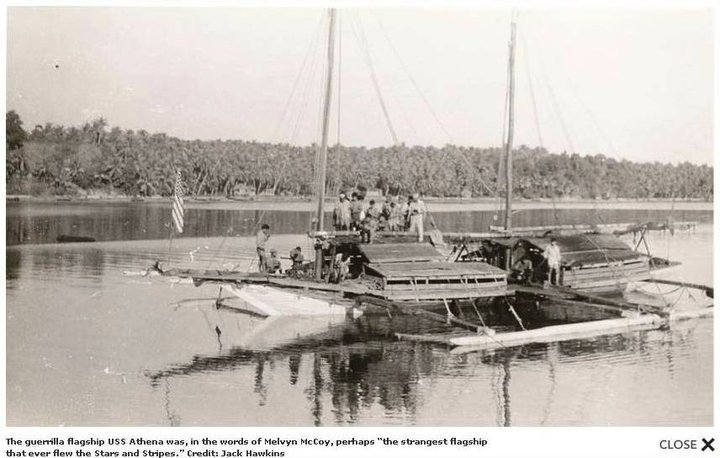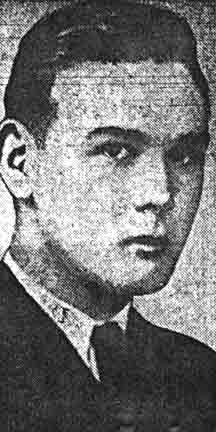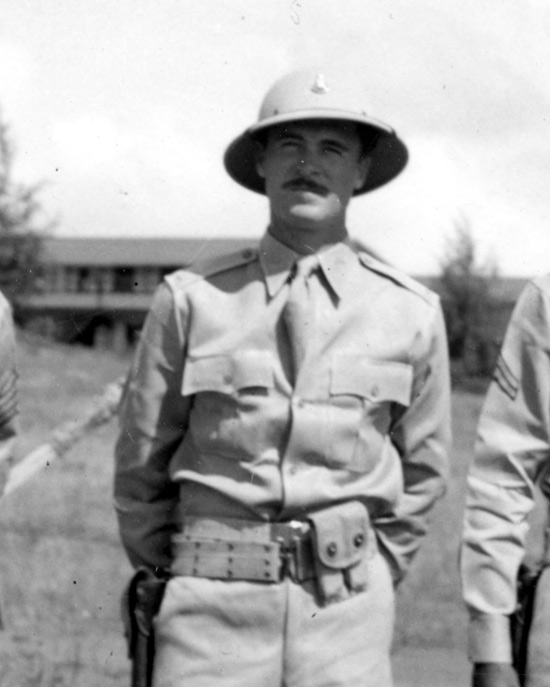Two of the Second World War’s largest naval battles were fought in the waters off the Philippines.
These were the Battle of the Philippine Sea on June 19-20, 1944, considered the largest carrier-to-carrier battle in history, involving 24 aircraft carriers , deploying roughly 1,350 carrier-aircraft ; and the Battle of Leyte Gulf on October 23-26, 1944, considered to have been the largest naval battle of World War II and, by some criteria, possibly the largest naval battle in history, , with over 200,000 naval personnel involved.
However, long before these two titanic battles happened, a different type of war was already being fought off the coasts of the occupied Philippines and Japanese garrison forces. Though minute in scope and scale compared to major naval engagements between the US and Imperial Japanese navies, it was a constant, running battle in the country’s inter-island waters, and considering the odds against them, deserves a story of their own for our guerrillas’ valor in daring to engage elements of the Japanese armed forces, albeit on a much smaller scale.
Business as usual
During the “3 taong walang Diyos” of the Japanese Occupation, Mindanao was still able to share food with adjacent areas in the Visayas, like Leyte, Cebu and Bohol. Slow-moving bancas were used to ply between Agusan and the Visayas.
In Lanao, periodic trips were undertaken by traders from Bohol, Negros, Siquijor, Cebu and Camiguin, bringing in sugar, garments, dried and salted fish, medicines and others. On their return trip, they brought with them rice, corn, and other food which were lacking in their places. Very often, these trips were undertaken by the ubiquitous Barco Dos Velas (Dos Velas means Two Sails in Spanish) sailboats.
“Barco Dos Velas was a 2-masted sailboat common between Visayas and Mindanao during colonial times,” said Antonio J. Montalvan II, a Europe-based Filipino public writer, social anthropologist, university professor and heritage activist. “These were the sailboats which many Visayan immigrants took when they moved to Mindanao.”
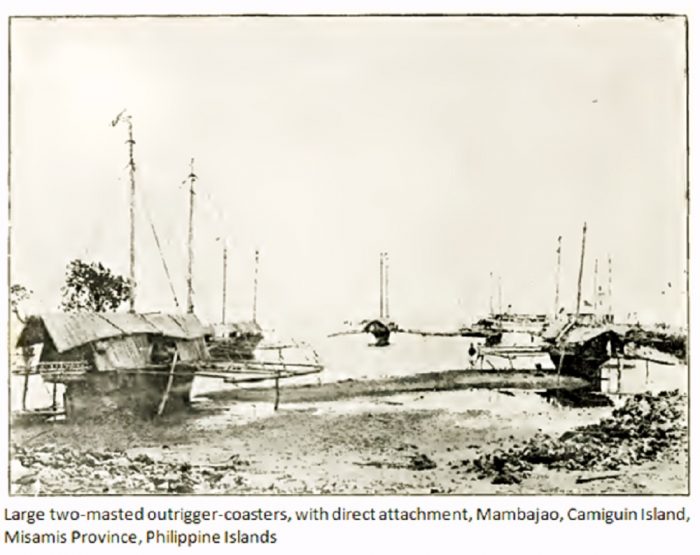
The Dos Velas were relatively large vessels and could accommodate up to one hundred sacks of corn, one hundred fifty kerosene cans of salted fish sauce (guinamos), and twenty men. With their huge sails, they were fast sailboats and together with the smaller bancas, revived the inter-island trade interrupted by the war. They traded in salt, corn, rice, guinamos, dried fish,, sugar and soap.
Normal trade relations existed between Lanao and Misamis Occidental. This trade relation, however, between these two provinces and from other islands in the Visayas, were at times paralyzed due to active Japanese patrols, both by land and sea.
The daring viajeros crossed the sea at night and hid in island coves during daytime to avoid Japanese sea patrols that prowled Macajalar and Iligan Bays searching for guerrillas going to and from Col. William Fertig’s headquarters at Misamis, Misamis Occidental. Fertig was the recognized overall guerrilla leader of the 10th Military District, United States Forces in the Philippines (USFIP) by Gen. Douglas MacArthur.
It was the usual practice of guerrillas going to Misamis to commandeer a sailboat, cross Iligan Bay at night to avoid Japanese motor launches based in Iligan, and arrive in Jimenez in the morning.
When a banca was commandeered, its skipper was given a “Jefe de Viaje”(Safe Passage Pass) by the area guerrilla commander which guaranteed him safe passage through territories controlled by the guerrillas.
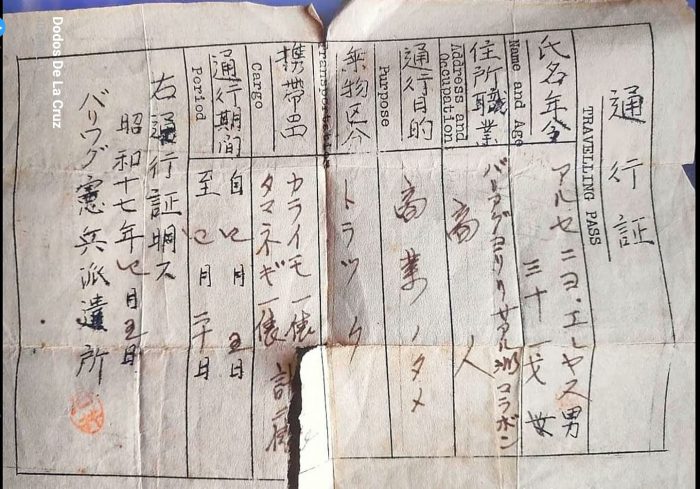
(shared by Neo K Wen in WWII Philippines).
However, savvy traders were also known to obtain similar safe passage passes from the Japanese (written in kana-hiragana) which they flashed when hailed by Japanese patrols. Of course, these were usually kept under wraps from the guerrillas.

The Japanese often intercepted the sailboats at sea, confiscating their cargo, and took the crew prisoner. Because of this, business declined and later, markets and retail stores were closed. The sudden rise of commodity prices inevitably followed.
Beginnings : The 110th Regiment ‘Navy’
It was evident at the very beginning that in order to organize all the small guerrilla bands in the eastern portion of Mindanao a fast and efficient means of water transportation was called for.
One of the guerrilla units which was most active in the littoral waters and the rivers and other waterways of Northern Mindanao was the 110th Infantry Regiment, charged with the area from the Tagoloan River, Misamis Oriental to the Eastern border of the province.
Activated early in November, 1942, it was composed mostly of various guerrilla bands which sprung up in Eastern Misamis Oriental during early September 1942: Balingasag and the surrounding towns led by Lt Pedro Collado; PFC (later 1st Lt), Clyde M. Abbot, Vicente Mercado and Sgt (later Lt.) Entique Carpio; Claveria under M/Sgt James McIntyre, U.S. Army Air Corps (USAAC); Malitbog under M/Sgt. Alfred Fernandez, USAAC; and Talisayan led by PFC Fausto Omandang.
110th Infantry Regiment, 10th MD, USFIP
The first commanding officer of this regiment was Capt. Pedro D. Collado who was designated on Nov. 1942, relieved by Capt. Francisco N. Luz on Feb. 1943, and succeeded by Maj. Rosauro P. Dongallo in June, 1943.
The guerrilla navy of this unit consisted of several coastal vessels, including bancas, motorized Barcos Dos Velas, captured Japanese launches mostly used to transport supplies delivered by submarines from Australia to guerrilla units around Mindanao.
The boats of the guerrilla “navy” were armed with machine guns salvaged off downed American and Japanese aircraft, home-made cannon, and even mortars. Later, some used 20 mm cannons supplied by the U.S. Navy. One vessel was even ‘armored’ using large, circular saws taken from abandoned sawmills.
Some of the actions these vessels participated in were heroic to the extreme, like when one small vessel deliberately engaged in a running battle with a large Japanese steamer, and in another, a sailing ship armed with 20 mm cannon, fought off Japanese aircraft and actually shot one down, perhaps establishing a record for being the only sailing ship to shoot down an airplane—a Japanese medium bomber.
Even more importantly, the crew salvaged a new Japanese bomb sight from the wreckage and sent it out on the next submarine to Australia.
The regiment found two launches on the seacoast of Misamis Oriental: the “Rosalia”, a light two masted banca powered by a 50HP diesel engine, and the “Treasure Island”, an inter-island passenger launch with a high superstructure and a 75 HP diesel engine.
These launches were commissioned in February, 1943. With launches in operation, it was necessary to locate an oil supply to provide fuel.
Captain Cruz Ranario, Division Quartermaster, solved this problem by building a kilometer long pipeline from the oil storage tank of the Surigao Consolidated Mine at Siana, Surigao to Tubay, where the oil was placed in oil drums which were floated down the creek to Tubay River, carried by baroto down the river to Tubay, where the oil was picked up and carried to fueling stations.
It was estimated that this oil storage tank, which was never touched by the Japs, contained over 200 tons of diesel fuel which was more than sufficient to operate the 110th Division’s launches for two years. An additional 60 tons of bunker fuel was siphoned out of the hulk of the SS Mayon sunk at Nasipit Harbor, but 52 tons of it was dumped by an American who thought bunker fuel was worthless.
Ammo Mission to Bohol
During the last day of the Siege of Butuan (March 3-10, 1943) when it was evident that the guerrillas’ ammunition was running low, Captain William Knortz took the launch “Rosalia” and went to Bohol, where a reliable source had reported that a certain individual had collected a large amount of ammunition after the surrender, but was holding it in secret for the Bohol Force, because there was some kind of agreement between the two parties.
Knortz contacted this individual and was able to obtain 8,000 rounds of ammunition and brought back the individual who knew the source. This ammunition was taken back and distributed to the troops.
As Knortz was pressed for time, he was not able to get all the hidden ammunition from Bohol. Major Clyde Childress and Knortz decided to return to Bohol to get the remainder.
In the meantime, the guerrillas had captured the “ Nara Maru” a 60-foot Japanese-made diesel motor launch which was converted to run on coconut oil. It was armed with a .50 caliber machine gun that was taken from a damaged B-17 bomber from the 19th Bombardment Squadron and had an improvised recoil mechanism made from rubber tubing.
Upon arriving in Jagna, Bohol, Childress in the launch “Treasure Island” and Knortz in the “Nara”, it was discovered that the commanding officer of the Bohol Force had learned of the ammunition raid and was very angry about it, and determined not to lose anymore to the interlopers from Mindanao.
However, while a conference was held with the officers of the Bohol Force, men were sent up into the hills and managed to get another 2,000 rounds. The decorum of the Bohol guerrillas was such as to indicate that they could start shooting anytime, so the party from the 110th Division boarded their launches and departed post haste to Mindanao.
The party stopped over at Mambajao, Camiguin, and heard from civilians that a submarine had landed at Misamis Occidental (actually in Lanao del Norte).
Sending the “Treasure Island” on to Mindanao, Knortz and Childress took the motor launch “Nara” to Misamis Occidental where they met Commander Charles “Chick” Parsons, who had just arrived from Australia at the headquarters of Col. Fertig in Oroquieta.
Parsons told them MacArthur had instructed the guerrillas to focus on intelligence gathering rather than attacking the Japanese garrisons.
Athena
Perhaps the most famous member of the guerrilla “navy” was the Athena, a two-masted Barco Dos Velas with outriggers, commonly used as commercial traders by Visayan traders from Panay, Negros, Siquijor and Bohol.
She was skippered by Major Vicente Zapanta, the legendary Butuanon of the Agusan River. Thought to be a US. Navy veteran of World War 1, he volunteered not only his service, but also his large sailing vessel with an auxiliary one cylinder diesel engine to the 110th Division in November 1942, turning his banca over to the army although he had been making a huge profit from it in the commercial trade.
Zapanta was commissioned as a 2nd Lieutenant but rapidly rose to the rank of Major in the USFIP and proved to be a valuable man to the organization.
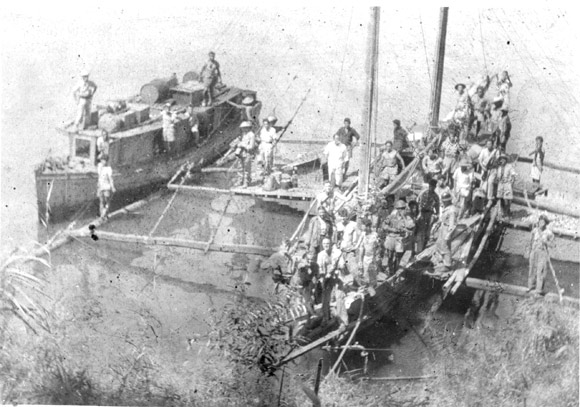
His banca was originally armed with a homemade muzzle loading cannon fashioned from a four-inch pipe which fired balls cast from melted fishing weights, but was later equipped with a 20mm cannon and .50-cal. machine guns, but never saw action on its many trips distributing supplies about the Visayan Islands and other coastal points in Mindanao. In addition, its 20 men crew were armed with Browning Automatic Rifles (BARs).
Athena’s major role during the war was to transport rice and other supplies to the various guerrilla-controlled towns, It also transported troops from one point of Mindanao to another. Zapanta was particularly helpful in delivering radio equipment to some of the coast watcher stations, Another mission was to bring evacuees to the next expected rendezvous with submarines such as the USS Narwhal.
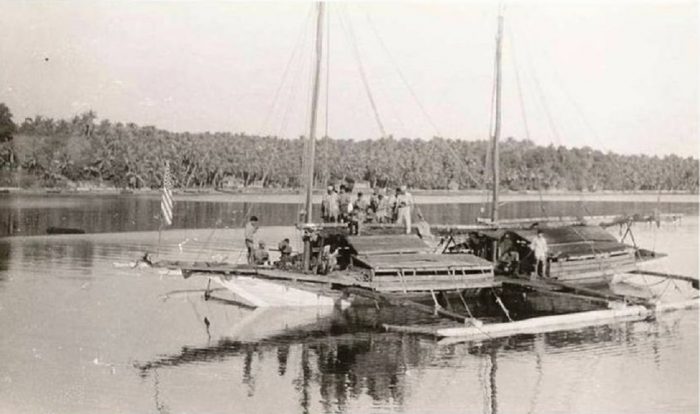
(Image-Jack Hawkins)
On one of these trips on January 1943, it picked up a large amount of USAFFE supplies from a beach at Manapa, Agusan, sequestered from Talacogon by Captain Knortz and Lt. Money left by Capt. Chastaine at the time of the surrender. This included the radio transmitter of the Anakan Lumber Company, which consisted of the transmitter itself, a steel cabinet two feet square and six feet high, a generator and many other pieces of personal equipment such as packs, canteens, bayonets, etc.
On her seventh war patrol and ninth Spyron mission, Narwhal skippered by Lt. Cmdr. Frank D. Latta, entered Butuan Bay submerged at 0508 hrs on November 15, 1943.
At 1605 hours, she sighted a launch flying the proper security signal. She surfaced and Colonel Wendell W. Fertig, commander of the United States Forces in the Philippines (USFIP) and head of the organized resistance in Mindanao, came aboard. Narwhal then proceeded to Nasipit Harbor. On her way in she ran aground on hard sand in the channel’s west bank, but managed to free herself quickly.
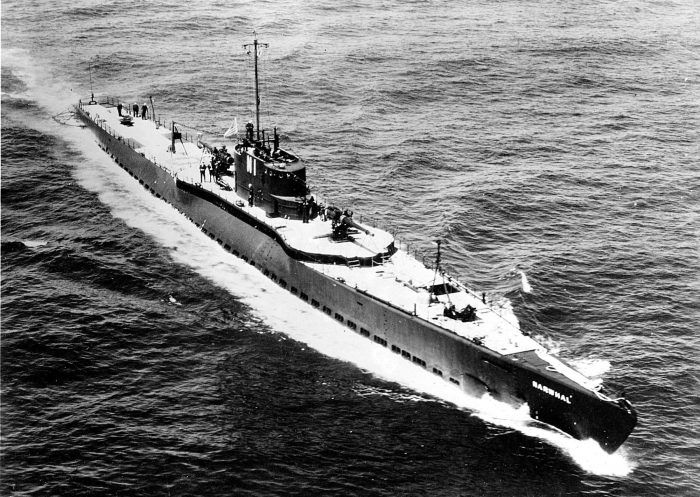
At 1746 hours, Narwhal moored starboard side at the Nasipit dock as a Filipino band played “Anchors Away.” At 2330 hours, she completed offloading 46 tons of supplies.
Early the next day, she embarked 32 evacuees, including POW escapees Shofner, Hawkins and Dobervich, women, two children, and one baby, and got underway. As Spyron Operations Chief, Lt. Cmdr. Chick Parsons left Narwhal with the harbor pilot.
Remarks the Narwhal’s patrol report: “The very real need for any kind of stores in guerrilla occupied areas led us to transfer considerably more stores than were actually consigned as cargo. Additional arms and ammunition as well as foodstuffs were transferred to Col. [Wendell] Fertig.
These supplies were distributed to the western portion of Mindanao and to others in the Visayan Islands by Zapanta’s “Athena”.
Albert McCarthy
A machine shop was set up at Fort Lamon, Surigao, in the old Port Lamon Lumber Company’s yard, which was destroyed by the 1942 typhoon. At this shop were 2nd Lt. Richard B. Lang and Waldo Neveling. The purpose of this shop was the construction and repair of launches and bancas.
The first launch to be constructed in this shop was the “Albert McCarthy” named after the brother of Lt. Joe McCarthy, who was killed in an ambush near Surigao City while on patrol against the Japs.
Capt. Knortz sailed this launch to the Division Headquarters at Linogus, Misamis Oriental (now Magsaysay), to get submarine supplies from Col. Fertig.
The supplies were received and the party returned, stopping at Balingasag, while Knortz in the launch, continued on up the coast.
A telephone call informed the Japanese had just landed at Gingoog and had taken control of the town. That same afternoon, Capt. Dobervich, USMC, arrived at Balingasag with a truck. A platoon of soldiers from the 110th Regiment Combat Company were sent immediately by truck to Gingoog to engage the Japs.
At Talisayan the M/L “Albert McCarthy” was found anchored and it was learned that Capt. Knortz and his armed party had proceeded to Gingoog on foot. The launch was unloaded and hidden, and the supplies loaded on the truck and sent to Medina where the Combat Co. troops unloaded and marched towards Gingoog.
It was learned that Knortz had entered Gingoog and killed eight Japs at close range with his tommy gun, and then had retired through the mountains. The troops arrived late and set up an outpost at Lunao crossing.
During the night a large Japanese patrol attacked the outpost and broke through it. Lt. Fritz was killed when the truck with the supplies he was driving was ambushed by the Japs.
Sea Mishap
The first Spyron operation in Northern Mindanao and seventh Spyron mission overall, involved the Bowfin (SS-287) under Cmdr. J. H. Willingham on Sept. 3, 1943 when it embarked nine persons and delivered seven tons of radio equipment and supplies at Iligan Bay, 1 ¼ mile east of Binuni Point (off present day Bacolod, Lanao del Norte).
Four weeks later on Sept. 29, 1943, at the same location, Bowfin evacuated nine guerrillas, selected by their superior officers, to be transported to Australia.
Capt. Knortz returned to Liangan, Lanao, arriving just after the Bowfin’s second shipment was unloaded and was able to get the largest shipment yet allocated to the 110th Division. However, his small launch was overloaded with the 13 people in addition to the weapons, packs and supplies and sank midway between Camiguin and Punta Diwata. Knortz downed and only six Filipinos survived.
So What
Waldo Neveling was a German national who was a former mining engineer at the Mindanao Mother Lode mine in Surigao province. Initially interned and then released by the Japanese because of his German nationality, he became a “soldier of fortune” and joined Fertig’s guerrilla organization, where he was commissioned a Captain in the 114th Regiment. He had been out of Germany for over 20 yrs and was not affiliated with the Nazi Party. He hated the Japanese but said he would not care to fight Germans.
At the Port Lamen machine shop, Neveling built a 50-foot two masted banca christened the “So What”, powered by a 25 HP diesel engine and mounting a 20mm cannon. It was fitted with circular saw blades on its gunnels that formed a sort of “armor” for the boat. Its primary mission was to transport supplies to the guerrillas, raid Japanese shipping and protect the mouth of the Agusan River.

With the 20mm cannon Neveling shot down a Japanese Betty Bomber, which crashed a few kilometers distant near Hinatuan.
Captain Knortz
When the Japs occupied Gingoog and Anakan, on the 1st of September 1943 they evacuated Butuan. Guerrillas found the Japs left a good river launch, a barge, and a 200-ton wooden lighter formerly owned by the Luzon Stevedoring Company.
The launch was easily repaired and christened “Captain Knortz” and patrolled Agusan River.
The barge was also repaired and pressed into service. The lighter was used on December 3, 1943 and 4th of March, 1944 to unload a hundred tons of submarine supplies.
For the December 3rd mission, the US Navy submarine Narwhal embarked seven evacuees – two soldiers, three civilian men, one woman, and one eight-year-old girl. She unloaded 92 tons of supplies, 300 gallons of lube oil, a small amount of hand tools, received three messages regarding the next phase of her mission, and used the portable radio station on the barge to send three messages. At 2205 hours, she got underway with Parsons aboard.
The Bastard
Another vessel in the Mindanao naval fleet, albeit not from the 110th Division, was the Bastard, a 26-foot whaleboat. Its skipper was Robert Kerr “Jock” McLaren, a captain in the Royal Australian Army who was part of a group of POWs that escaped from a Japanese concentration camp in Sandakan, Borneo, made their way to Mindanao and served in the Tenth Military District in various capacities until the end of the war.
Australian military involvement in the liberation of the Philippines began in June 1943, when eight Australian Servicemen who had escaped from Sandakan in Sabah joined the Filipino guerrillas fighting on Tawi-Tawi in the southern Philippines. Two of the men were killed during fighting and three others returned to Australia in early 1944, while the three remaining soldiers were transferred to Special Operations Australia and continued to fight on Mindanao until the island was liberated in 1945.
As part of ‘E’ Force, McLaren was among five hundred British and five hundred Australian prisoners transferred to Borneo in March 1943. The Australians were taken to a camp on Berhala Island, at the entrance to Sandakan harbour in British North Borneo.
McLaren and Lieutenant Rex Blow made contact with Filipino guerrillas who helped them and five others to escape in June. Another Australian, already at large, joined the group which then sailed to the island of Tawitawi in the Philippines.
Attaching themselves to an American-led guerrilla force, the men sailed for Mindanao in October. McLaren had been promoted sergeant in July. He was to serve with distinction in the Philippines, receiving a field commission (January 1944) and the rank of temporary captain (April 1945) with the 105th Infantry Regiment in Tawi-Tawi, and later with the 108th Division in Lanao.
From September 1944 McLaren skippered an armed whaleboat Bastard off Mindanao. He attacked Japanese small craft and coastal installations with dash and aggression, qualities he also displayed when commanding combat patrols on land.
McLaren’s boat had a 20-millimeter cannon mounted in the bow, twin 30-inch guns amidships and a .50 caliber gun in the after part of the craft. Another unique feature was an 82-millimeter mortar in the craft’s stern.
The boat would sail into Japanese-controlled ports in daylight hours, direct its automatic fire at the piers and fire its mortar at Japanese boats. It is said that its crew would even challenge the Japanese by sending them invitations. This craft was also effective against Japanese aircraft.
A last addition to the guerrilla navy was a group of small, fast sailboats and escort launches that had machine guns or 20- or 30-millimeter cannons. These small craft would protect the delivery of supplies that had been brought in by submarine.
On 2 April 1945 he and Blow headed elements of the guerrilla force’s 108th Division in an assault on the last Japanese stronghold in Lanao province. Lieutenant Colonel Charles W. Hedges, the American divisional commander, recorded that the fighting ended with the capture of the garrison and the destruction of about 450 enemy troops.
For his efforts at sea and on land, McLaren won the Military Cross and was mentioned in dispatches. His M.C. citation read: ‘throughout the whole of his service with the Guerilla Forces, Captain McLaren displayed outstanding leadership in battle and had no regard for his personal safety. His cheerful imperturbability was an inspiration to all with whom he came into contact’. The Americans awarded him the Philippines Liberation ribbon.
-30-
References:
- Memoirs of the Guerrillas: The Barefoot Army, by Jesus B. Ilogon. pp. 47-49
- Keats, John. (1965). They Fought Alone. Pocket Books, Inc. OCLC 251563972, pp. 358-359, 375-379, 383,
- Schmidt, Larry. (1982). American Involvement in the Filipino Resistance on Mindanao During the Japanese Occupation, 1942–1945. (PDF). M.S. Thesis. U.S. Army Command and General Staff College. 274 pp., pp. 211-212
- History of the 110th Division, 10th Military District (MD) (PVAO Digitized Collection, pp. 3, 4, 5,
- Holmes, Kent. Wendell Fertig and His Guerrilla Forces in the Philippines: 1942-1945) pp. 110,
- USS Nautilus(SS-168) Report of War Patrol Number Fourteen, 3 January 1945 – 30 January 1945. Dated 30 January 1945. SS168/A16-3, Serial 001.
- Australian War Memorial
- Gilling, Tom. Jock McLaren, Australia’s ‘cloak and dagger’ war hero, The Weekend Australian, January 30, 2021 (Retrieved April 24, 2021)
